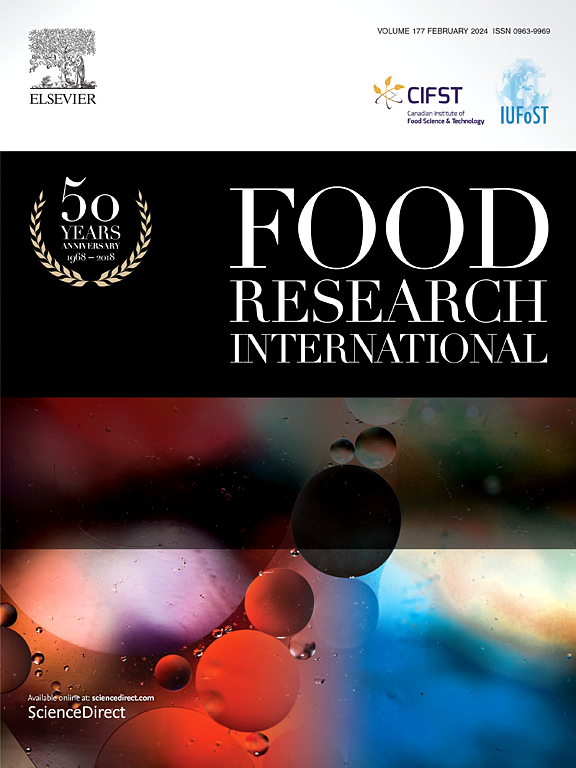Biopreservation technology of sourdough co-fermented with Fructilactobacillus sanfranciscensis and Propionibacterium freudenreichii: Effects and mechanisms for enhancing bread quality and extending shelf life
IF 7
1区 农林科学
Q1 FOOD SCIENCE & TECHNOLOGY
引用次数: 0
Abstract
This study presents a biopreservation method using sourdough co-fermented with Fructilactobacillus sanfranciscensis and Propionibacterium freudenreichii, optimizing conditions to 220 hydration and 24 h fermentation. The composite sourdough bread quality was evaluated through physicochemical, storage, sensory, and microbial tests, with mechanisms analyzed based on microstructure, rheology, and dough structure. Results showed that: first, the composite sourdough enhanced bread physicochemical properties, increasing volume, height-to-diameter ratio, elasticity, and resilience, while reducing baking loss, hardness, chewiness, and adhesiveness. Second, it improved bread storage performance by increasing moisture content, reducing moisture loss, hardness, aging rate and retrogradation enthalpy. Third, it improved bread color by enhancing Maillard reaction browning, reducing ΔE, and maintaining color stability during storage, while improving sensory attributes such as mouthfeel, texture and flavor. Fourth, the composite sourdough inhibited mold and bacterial growth, extending shelf life to the ninth day. Mechanistic analysis revealed that at the micro level, it increased colony counts of Fructilactobacillus sanfranciscensis and Propionibacterium freudenreichii, enhanced organic acid content (lactic acid, propionic acid, succinic acid), and lowered pH to inhibit harmful microbes. At the macro level, it optimized fermentation rheology by improving expansion height, gas retention, and reducing collapse, while improving dynamic rheology, lowering G' and G", and increasing tanδ, enhancing viscoelasticity and softness. Additionally, it improved dough structure by enhancing free thiol groups, amino groups, and free amino acids, optimizing secondary structure. This study shows that the composite strain improves bread quality and shelf life by optimizing sourdough microbial properties, rheology, and dough structure, providing a promising biopreservation method.

三弗朗西斯果乳杆菌和弗氏丙酸杆菌共发酵酵母的生物保存技术:提高面包品质和延长保质期的效果和机制
本研究以三弗朗西斯果乳杆菌和弗氏丙酸杆菌共同发酵的酵母为原料,优化条件为220水合,发酵24 h。通过理化、贮藏、感官和微生物等试验对复合酵母面包的品质进行了评价,并从微观结构、流变学和面团结构等方面分析了复合酵母面包的品质机理。结果表明:第一,复合酵母改善了面包的理化性能,提高了面包的体积、高径比、弹性和回弹性,同时降低了面包的烘烤损失、硬度、嚼劲和粘附性。二是通过提高面包含水率、降低水分损失、硬度、老化速率和退化焓来改善面包的贮藏性能。第三,通过增强美拉德反应褐变,降低ΔE,并在储存过程中保持颜色稳定性,同时改善口感,质地和风味等感官属性,改善面包的颜色。第四,复合酵母抑制霉菌和细菌生长,将保质期延长至第9天。机理分析表明,在微观水平上,它增加了三弗朗西斯乳杆菌和弗氏丙酸杆菌的菌落计数,提高了有机酸(乳酸、丙酸、琥珀酸)含量,降低了pH值,对有害微生物有抑制作用。宏观上,通过提高发酵高度、气潴留、减少塌缩来优化发酵流变学,同时改善动态流变学,降低G′和G”,增加tanδ,增强粘弹性和柔软性。此外,通过增加游离巯基、氨基和游离氨基酸来改善面团结构,优化二级结构。本研究表明,复合菌株通过优化酵母微生物特性、流变学和面团结构,改善面包品质和保质期,为生物保存提供了一种很有前景的方法。
本文章由计算机程序翻译,如有差异,请以英文原文为准。
求助全文
约1分钟内获得全文
求助全文
来源期刊

Food Research International
工程技术-食品科技
CiteScore
12.50
自引率
7.40%
发文量
1183
审稿时长
79 days
期刊介绍:
Food Research International serves as a rapid dissemination platform for significant and impactful research in food science, technology, engineering, and nutrition. The journal focuses on publishing novel, high-quality, and high-impact review papers, original research papers, and letters to the editors across various disciplines in the science and technology of food. Additionally, it follows a policy of publishing special issues on topical and emergent subjects in food research or related areas. Selected, peer-reviewed papers from scientific meetings, workshops, and conferences on the science, technology, and engineering of foods are also featured in special issues.
 求助内容:
求助内容: 应助结果提醒方式:
应助结果提醒方式:


